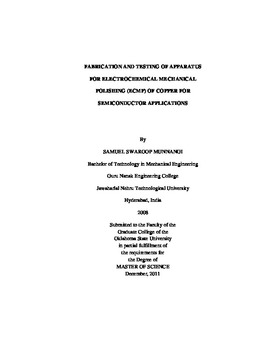| dc.contributor.advisor | Komanduri, Ranga | |
| dc.contributor.author | Munnangi, Samuel Swaroop | |
| dc.date.accessioned | 2014-04-17T19:53:16Z | |
| dc.date.available | 2014-04-17T19:53:16Z | |
| dc.date.issued | 2011-12-01 | |
| dc.identifier.uri | https://hdl.handle.net/11244/10004 | |
| dc.description.abstract | Electrochemical mechanical polishing (ECMP) is a process wherein the surface layer of a substrate is smoothened using a combination of electrochemical reactions, chemical reactions and mechanical forces. It is an alternative technology to chemical mechanical polishing (CMP) to prevent delamination in the porous low-k dielectric films in advanced IC devices. Copper is widely used in the metallization of these device structures. ECMP is excellent for bulk copper planarization because it has higher material removal rates and better planarization efficiency at low down-force. Also, ECMP has proven to be better than electrochemical polishing (ECP) as it is not pattern sensitive. In the present study, a face-up ECMP apparatus with planetary motion was fabricated and tested to polish 4-inch copper wafers. A ball bearing arrangement was used to provide a positive charge to the rotating wafer in the wafer carrier. Five different slurry compositions were prepared to polish the copper wafers. Multi-stage polishing was adopted to achieve a good surface finish on the wafer. Surface characterization was studied by optical microscope and MicroXAM, an optical laser interference microscope. The slurry composition for ECMP should be such that it forms a passivation layer on the surface of the copper wafer which is subsequently removed by the polishing pad. The necessary components of the slurry, in order to produce a good surface finish are an acid-based electrolyte, a corrosion inhibitor, a leveling agent, an oxidizer, a pH adjusting agent, and abrasive particles. The slurries with pH of 6 or above produced a smooth uniform surface. This was validated using Pourbaix diagram of copper. Phosphoric acid-based slurry with a pH of 6 and Buehler alumina-based slurry with a pH of 9 produced a good surface finish. The surface roughness obtained with the phosphoric acid-based slurry was 12.05 nm. Process parameters, such as polishing time, voltage applied, pad and wafer carrier speed were studied as a function of material removal rate and surface roughness. Material removal rates increased with increase in polishing time and applied voltage. Good surface finish was obtained with a polishing time of 10 minutes at a voltage range of 9.5 to 10.5 V with a wafer carrier speed of 15 rpm and a pad speed of 325 rpm. | |
| dc.format | application/pdf | |
| dc.language | en_US | |
| dc.publisher | Oklahoma State University | |
| dc.rights | Copyright is held by the author who has granted the Oklahoma State University Library the non-exclusive right to share this material in its institutional repository. Contact Digital Library Services at lib-dls@okstate.edu or 405-744-9161 for the permission policy on the use, reproduction or distribution of this material. | |
| dc.title | Fabrication and Testing of Apparatus for Electrochemical Mechanical Polishing (ECMP) of Copper for Semiconductor Applications | |
| dc.type | text | |
| dc.contributor.committeeMember | Harimkar, Sandip | |
| dc.contributor.committeeMember | Kong, Zhenyu | |
| osu.filename | Munnangi_okstate_0664M_11716.pdf | |
| osu.college | Engineering, Architecture, and Technology | |
| osu.accesstype | Open Access | |
| dc.description.department | Mechanical & Aerospace Engineering | |
| dc.type.genre | Thesis | |
| dc.subject.keywords | copper wafers | |
| dc.subject.keywords | electrochemical mechanical polishing (ecmp) | |
| dc.subject.keywords | material removal rate (mrr) | |
| dc.subject.keywords | slurry ph | |
| dc.subject.keywords | surface roughness (ra)</ | |
